Related Research Articles
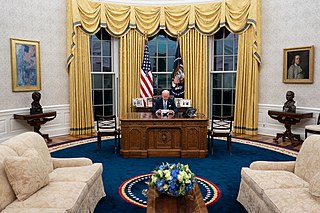
The Oval Office is the formal working space of the president of the United States. Part of the Executive Office of the President of the United States, it is in the West Wing of the White House, in Washington, D.C.
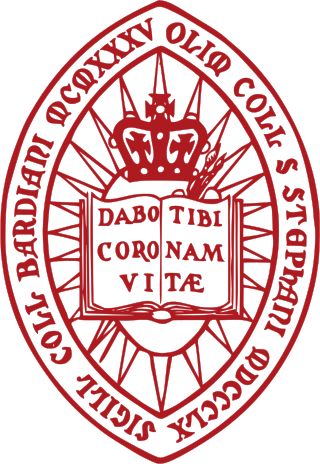
Bard College is a private liberal arts college in the hamlet of Annandale-on-Hudson, in the town of Red Hook, in New York State. The campus overlooks the Hudson River and Catskill Mountains within the Hudson River Historic District—a National Historic Landmark.

Caroline Lavinia Harrison was an American music teacher and the first lady of the United States from 1889 until her death. She was married to President Benjamin Harrison, and she was the second first lady to die while serving in that role.

The Museum of Fine Arts is an art museum in Boston, Massachusetts, United States. It is the 20th-largest art museum in the world, measured by public gallery area. It contains 8,161 paintings and more than 450,000 works of art, making it one of the most comprehensive collections in the Americas. With more than 1.2 million visitors a year, it is the 52nd–most visited art museum in the world as of 2019.

The Minneapolis Institute of Art (Mia) is an arts museum located in Minneapolis, Minnesota, United States. Home to more than 90,000 works of art representing 5,000 years of world history, Mia is one of the largest art museums in the United States. Its permanent collection includes world-famous works that embody the highest levels of artistic achievement, spanning about 20,000 years and representing the world's diverse cultures across six continents. The museum has seven curatorial areas: Arts of Africa & the Americas; Contemporary Art; Decorative Arts, Textiles & Sculpture; Asian Art; Paintings; Photography and New Media; and Prints and Drawings.

Uriah Phillips Levy was a naval officer, real estate investor, and philanthropist. He was a veteran of the War of 1812 and the first Jewish Commodore of the United States Navy. He was instrumental in helping to end the Navy's practice of flogging, and during his half-century-long service prevailed against the antisemitism he faced among some of his fellow naval officers.

The Green Room is one of three state parlors on the first floor of the White House, the home of the president of the United States. It is used for small receptions and teas. During a state dinner, guests are served cocktails in the three state parlors before the president, first lady, and a visiting head of state descend the Grand Staircase for dinner. The room is traditionally decorated in shades of green. The room is approximately 28 by 22.5 feet. It has six doors, which open into the Cross Hall, East Room, South Portico, and Blue Room.

Alma Woodsey Thomas was an African-American artist and teacher who lived and worked in Washington, D.C., and is now recognized as a major American painter of the 20th century. Thomas is best known for the "exuberant", colorful, abstract paintings that she created after her retirement from a 35-year career teaching art at Washington's Shaw Junior High School.

The White House Office of the Curator is charged with the conservation and study of the collection of fine art, furniture, and decorative objects used to furnish both the public and private rooms of the White House as an official residence and as an accredited historic house museum.
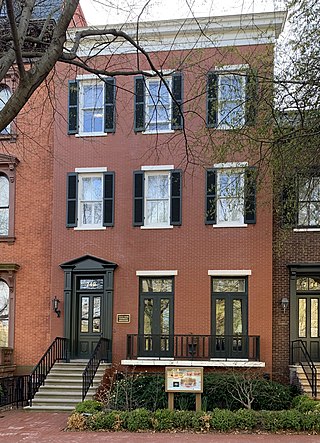
The White House Historical Association, founded in 1961 through efforts of First Lady Jacqueline Kennedy, is a private, non-profit organization that works to preserve the history of the White House and make that history more accessible to the public. As of March 2022, the president of the association is Stewart McLaurin.
William Seale was an American historian and author whose primary interest was in historic architecture, particularly that of the White House, state capitols, and historic governors' mansions, who was "instrumental in preserving many historic structures across the country", including private homes. In 1983, he founded the scholarly journal White House History, which he edited for the White House Historical Association until his death.

The Institute for the Study of the Ancient World (ISAW) is a center for advanced scholarly research and graduate education at New York University. ISAW's mission is to cultivate comparative, connective investigations of the ancient world from the western Mediterranean to China. Areas of specialty among ISAW's faculty include the Greco-Roman world, the Ancient Near East, Egypt, Central Asia and the Silk Road, East Asian art and archaeology, Late Antiquity and the early Middle Ages, ancient science, and digital humanities.
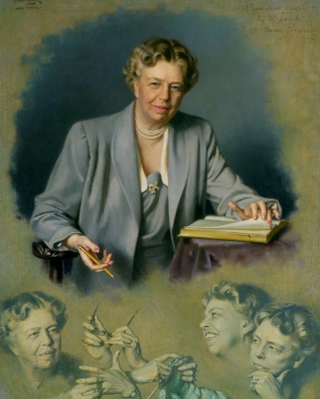
My Day was a newspaper column written by First Lady of the United States Eleanor Roosevelt (ER) six days a week from December 31, 1935, to September 26, 1962. In her column, Roosevelt discussed issues including civil rights, women's rights, and various current events. This column allowed ER to spread her ideas, thoughts, and perspectives on contemporary events to the American public through local newspapers. Through My Day, Roosevelt became the first First Lady to write a daily newspaper column. Roosevelt also wrote for Ladies Home Journal, McCall's, and published various articles in Vogue and other women's magazines.
Dorothy M. Kosinski is an American scholar of nineteenth and twentieth-century art, curator and the former director (2008--2023) of The Phillips Collection, an art museum in Washington, D. C.

Isabella Louisa Hagner James was the first White House Social Secretary. She served in the administrations of President Theodore Roosevelt, William Howard Taft, and Woodrow Wilson.

A statue of American Founding Father and U.S. President Thomas Jefferson by the French sculptor David d'Angers stands in the Capitol rotunda of the U.S. Congress. Jefferson is portrayed holding a copy of the United States Declaration of Independence, which he mainly drafted in 1776 as a member of the Committee of Five during the Second Continental Congress. The painted plaster model also stood in the chambers of the New York City Council.

The White House's art collection, sometimes also called the White House Collection or Pride of the American Nation, has grown over time from donations from descendants of the Founding Fathers to commissions by established artists. It comprises paintings, sculptures, and other art forms. At times, the collection grows from a president's specific request, such as when Ronald Reagan began collecting the work of naval artist Tom Freeman in 1986, a tradition that continued through the Obama years.
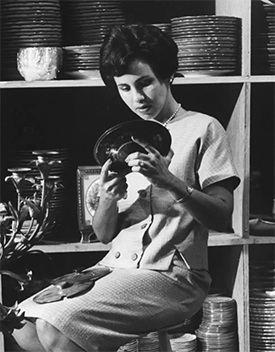
Lorraine Waxman Pearce, sometimes known as Lorraine Pearce, was a decorative arts scholar and the inaugural White House art curator, key to the Kennedy restoration of the White House.
Betty C. Monkman is a former White House Curator and author of The White House: Its Historic Furnishings and First Families and The Living White House.

Grace Hoops is a genre painting by the American artist Winslow Homer. It depicts two young women outdoors playing the game of graces. Scenes of childhood innocence constituted one of Homer's recurring subjects throughout the 1870s. The work is now in the collection of the McMullen Museum of Art at Boston College, having been donated as part of the Carolyn A. and Peter S. Lynch collection.
References
- ↑ WRAL (2021-01-15). "Taxidermy and a Lincoln bust among departing White House effects" . Retrieved 2022-04-20.
- ↑ "Lydia Tederick". WHHA (en-US). Retrieved 2022-02-17.
- ↑ Hanley Stawicki, Jody. "From the White House to the Classroom: Bringing American History to Life through the Study of First Ladies". OAH Magazine of History. 15 (3): 37–44.
- ↑ Wilner, Eli (2000). The Gilded Edge: The Art of the Frame. Chronicle Books. ISBN 978-0-8118-2070-7.
- ↑ Kelly, John (2018-10-20). "Perspective, A private citizen gave a stunning statue to Congress. Lawmakers didn't want it". Washington Post. ISSN 0190-8286 . Retrieved 2022-04-20.
- ↑ "Uriah Levy's Gift to the Nation". WHHA (en-US). Retrieved 2022-04-20.
- ↑ "The Decorative Arts in the White House Symposium by White House Historical Association - Issuu". issuu.com. Retrieved 2022-02-17.